The October 2023 Teesta Floods and the acronym GLOF are not going to be easily erased from our memories, especially when it rains in the first week of October. Neither is the scarring of the landscape and the river flowing alongside houses, roads and highways going to heal overnight, considering very little was done for the rehabilitation of the landscape. What has faded is the much needed national and mainstream media focus on the issue and dialogue for rehabilitation and resilience building. As a region we have to ask the question, are we left to live with the impacts of the Teesta Disaster 2023 or are we going to learn from it and build back better?
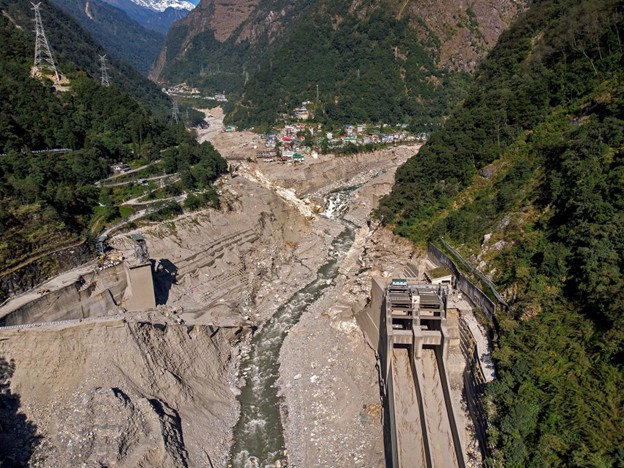
On 4 October 2023, the River Teesta rose to catastrophic levels leaving a trail of devastation and destruction that Sikkim, Darjeeling and Kalimpong are still recovering from. The Glacial Lake Outburst Flood (GLOF) from the South Lonak Lake in North Sikkim at 17,300 feet above mean sea level came crashing down the Lachen Chu in North Sikkim wrecking havoc along its path. The waters raced down into the already brimming reservoir of the 1200MW Sikkim Urja Dam at Chungthang (5870ft AMSL) which was quickly overwhelmed and burst, releasing a wall of water that unleashed with a rage not experienced in our lifetime. The deluge swept through the Teesta valley, destroying everything in its 162 km rampage from the glacier to NHPC Teesta Low Dam Project (TLDP) III at 27th Mile in Kalimpong district. It continued its destructive flow into parts of North Bengal and Bangladesh.
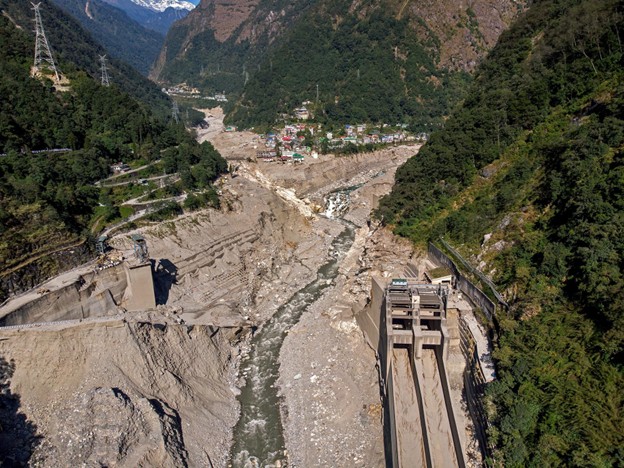
Countless lives and livelihoods were lost (some documented and many not counted nor considered). Roads, bridges, hydropower dams, defense installations were washed away on that fateful day. For a disaster this size, the mainstream media coverage was limited and was mostly reported as the ‘Sikkim Disaster’. It did not help that West Bengal failed to officially call it a disaster. There was an outpouring of community response with leaders and volunteers pouring out in great numbers in Sikkim, Darjeeling and Kaimpong to clear out the rubble and provide relief especially to people who lived along the lower reaches of the Teesta. Relief work began with great gusto but we realise that it is not so simple as building houses alone or distributing financial aid, it needs to make sense to the lives of the impacted communities. The memory of the disaster continues till date especially during the monsoons, yet these memories have not been converted to concerted action that is visionary and necessary.
Post the tragic GLOF event, we have lived through 2 monsoons. It is now a given, that the lifeline to Kalimpong and Sikkim from Siliguri will be broken multiple times during the rains, that Teesta will breach its bank at the slightest of upstream rainfall and overflow onto the highway, stalling traffic for hours on end. It is accepted that North Sikkim will get cut off and there will be more dramatic landslides impacting lives, livelihoods and the landscape. It has become common to see a stream of vehicles to Sikkim passing by Kalimpong or Darjeeling with the frequent closing of NH 10 due to landslides, rockfalls or the highway sinking. These alternate routes take at the very least double the normal travel time and the costs on the driver’s wellbeing, travelers’ added expenditures, disturbance caused to communities, and the perilous conditions of the alternate roads find little mention and are not factored. Two dry seasons have passed by but not much has been done for long term rehabilitation of the impacts of the disaster and strengthening infrastructure that does not come tumbling down with the rains.
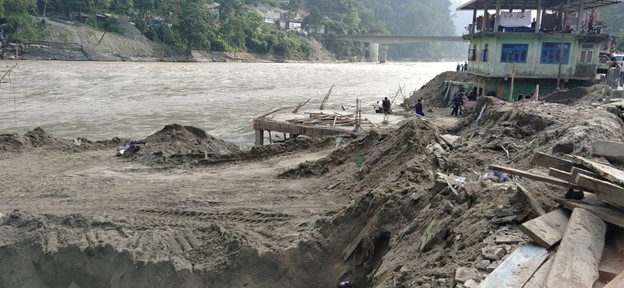
The urgency and criticality for action is highlighted by the Centre of Science 2025 analysis of India’s Atlas on Weather Disasters which shows that the Himalaya have faced extreme weather for 822 days since 2022, killing 2,683 people across 13 states and UTs. The 2025 monsoon has been extremely harsh on the people and ecology of the Himalaya with a spate of big disasters. An analysis of news for 2025 till date shows that more than 1774 lives lost, 448 injured, 176 missing and over Rs 12 crores loss estimated. The increasing frequency and magnitude of disasters in our Himalaya is a result of our development trajectories as well as impacts of climate crisis impacts.
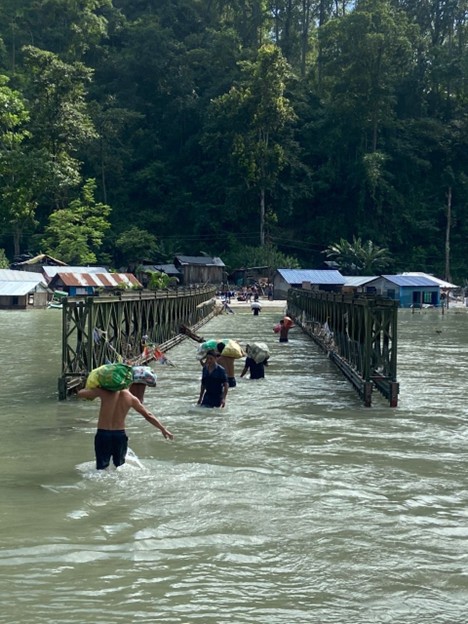
The Teesta Disaster 2023 with its catastrophic magnitude showed flaws in our development choices, disaster management systems, priorities including national and regional focuses. The GLOF is largely due to the impacts of the climate crisis that has resulted in faster melting of glaciers in the Himalaya as global warming is affecting the Himalaya most after the poles. A global phenomenon due to the production and consumption patterns of the industrialised nations and regions, impacts a low carbon footprint Himalaya with no global mechanism to compensate for the loss and damage to a vulnerable region. The GLOF waters added to the Chungthang Dam waters wreaking havoc and adding to the discourse against misplaced large hydropower in the Himalaya that is extractive as well as destructive of the landscape and people.
At a national level, mountain disasters do not feature high on the priority list with a response system that is based on body counts and not socio-ecological loss and damage. The disasters in the Himalaya especially if it is not in urban spaces just do not add up to large numbers that bring national focus that is needed for proper response. The first line of response in the Teesta Disaster were the immediate communities highlighting the need for local capacities in disaster response. While significant relief work was invested it did not get translated to the transboundary regional needs that the Teesta river basin flows through. The ‘Sikkim Disaster’ narrative limited interventions to a singular state and did not focus on interstate collaborative effort that was much needed. The response in itself was highly relief centric and with memory fading, rehabilitation work that is sustainable, disaster resilient, livelihood focussed and based on community participation and equity did not take priority. These insights are inherent flaws in the disaster management institutions that are siloed and without the much needed synergies across different governments departments and people. Teesta Disaster 2023 cannot be just looked at from a relief and rehabilitation lens; it is a socio-ecological restorative, justice and equity issue that goes beyond departmental and political boundaries. This cannot be done just at the local level but requires policy and adequate resource allocations.
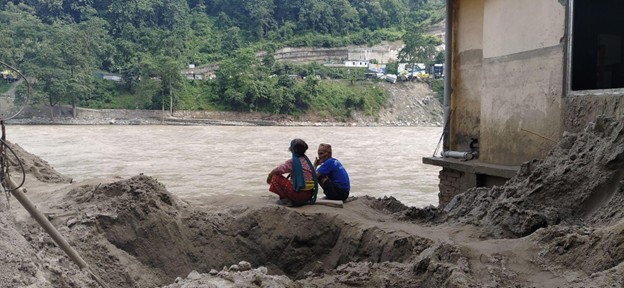
Darjeeling Himalaya Initiative and Save the Hills led by Wing Commander Praful Rao, in three memorandums (2023 to 2024) had called on the need for an expert committee that recommends short, medium and long term action for resilience building and implementation of these interventions with utmost priority. They seem to have fallen to deaf ears as the Teesta still flows way above the danger marks, communication infrastructure keeps breaking and landslides keep occurring across the landscape with communities impacted by it constantly with immediate relief or bandaid interventions the priority.
The Teesta Disaster 2023 must not fade away from our memories, we need to proactively engage with it and incorporate them in our development strategies that makes our landscape and communities more resilient. It cannot be relegated to a 2023 history only, as disasters in our region cannot be looked at from a singular timeline but a continuum that cascades with lessons to be learnt from. The Teesta had risen in rage in October 1968 too and could rise up once again as the South Lonak Lake, and many other glacial lakes are still expanding. We cannot afford once again to say that scientists and experts had predicted the GLOF and not take any action. It is critically important to take this forward as a sustainable mountain development issue that questions how infrastructure is built in the mountains, especially large dams and roads. National policies, practices and resource allocation to the Himalaya have to be sensitive and appropriate to the importance and fragility of our landscapes. Engagement at a transboundary landscape level that goes beyond administrative, political and bureaucratic boundaries for collaborative visioning and planning is much needed. Ensuring loss and damage is minimal in the future and most importantly our interventions in the Sikkim and Darjeeling Himalaya must be such that they do not invite disasters. We might forget the Teesta Disaster 2023 but Teesta never forgets and the choice and responsibility is ours.
Writes – Roshan Rai. Development Worker at DLR Prerna, Secretary Integrated Mountain Initiative and Darjeeling Himalaya Initiative and member Zero Waste Himalaya.


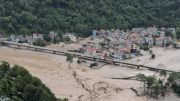



The solution to this recurring environmental problem can only be solved with the active participation of the Central Government and the State Governments of Sikkim and West Bengal. A National Policy must be framed, without the Centre’s committed intervention it’s well nigh impossible for preventing such recurring disasters.
Relegating this to the backburner spells doom for the fragile Himalayan regions of India.